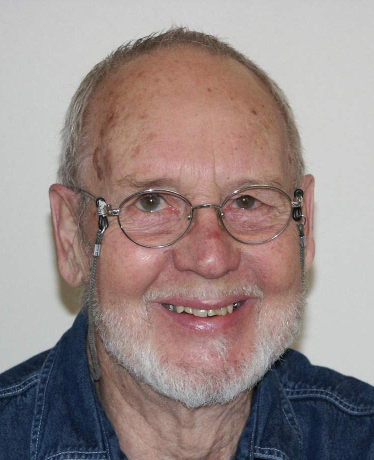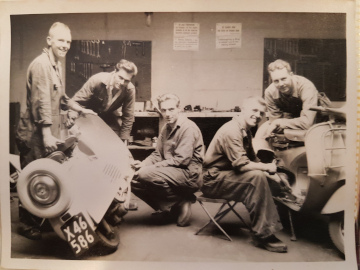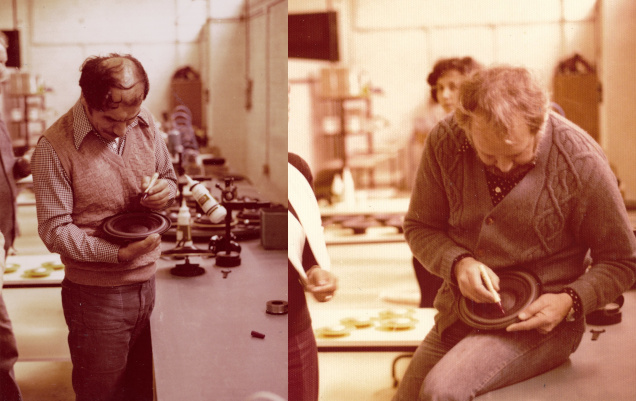Ejvind Skaaning
Mr. Ejvind Skaaning was born on April 17th, 1929, in the small town of Vejen, Denmark. After finishing 10 years of school, he served as an apprentice, and during World War II he became an auto mechanic. He passed away on 8. February 2018, survived by his children. It happened peacefully and without drama at Horsens Hospital.
 Picture of Ejvind Skaaning.
Picture of Ejvind Skaaning.
Skaaning quickly became interested in music, when his grandfather, who was a captain at DFDS, purchased a phonograph in the USA and brought it home.
After a few more years in Vejen he moved to the city of Aarhus, where be was employed with Ford Motor Company. Ford was the authorized importer and dealer for Vespa Scooters. In the early 1950ties, Ejvind took over the Vespa dealership, and started Aarhus Scooter, which he builds into a successful dealership. His store was actually one of the best performing dealers in Europe one year.
 Picture of Aarhus Scooter, Ejvind Skaaning on the right side (Source: Per Skaaning).
Picture of Aarhus Scooter, Ejvind Skaaning on the right side (Source: Per Skaaning).
Approximately in the mid 50ties Ejvind Skaaning had to switch a scooter for a tape recorder and he became a dedicated tape amateur recorder. He became a member of the Aarhus Baand Amatør Klub (eng.: Aarhus Tape recording Amateur Club), a club for audio enthusiasts, making recordings, building speakers, etc. Skaaning made several recordings with a tube-equipped Tandberg machine, among them Aarhus byorkester (eng.: Aarhus city orchestra). Typical for Skaaning, the tape recorders were modified with a different (bigger) homemade capstan axle and were recorded in double speed, for increased dynamics and reduced noise.
Ejvind Skaaning founded QSR (Quality Sound Recordings) and published several records on vinyl (as in LP's), primarily with classical organ music.
Ejvind Skaaning did not find commercial amplifiers and loudspeakers particularly good, so he started DIY (do it yourself). Ejvind Skaaning started to build speakers for friends and family in his basement, and slowly his hobby became a new business. The speakers were based on Peerless drivers. It quickly showed that Skaaning had talent and he supplied friends and connections with homemade amplifiers and speakers.
Skaaning was manufacturing furniture and loudspeakers for orchestras, friends and associates, as a hobby. His son, Per Skaaning, is born 1960.
In the mid 1960's, Ejvind sold Aarhus Scooter, and dedicated himself full time to his fledgling loudspeaker business. With some of the money from the sale of Aarhus Scooter he build a small sound laboratory in the attic of his house, and invested in some machinery for manufacturing loudspeaker cabinets. The record company part was no longer active as he had no time for it, but the company was at this point in time still named QSR.
In the basement of his house, Skaaning has a metal workshop. He helps his brother who has a furniture factory by providing metal parts, for example a metal-foot for a chair, which can swivel/rotate. In return, his brother makes loudspeaker cabinets for Skaaning.
One day in the spring of 1968, Peter Hasselriis called Ejvind Skaaning. Hasselriis was the CEO of Dynaco Europe. David Hafler is in Denmark and they meet with Skaaning. The prototype is accepted. Afterwards Scandyna would like Skaaning to manufacture 2500 loudspeakers as a supplement to the Dynaco loudspeakers. This was an early predecessor to the Dynaco A-25. The A-25 is designed/engineered (and manufactured) by Ejvind Skaaning.
This webpage claims that the A-25 was designed by M. Stauning of SEAS Fabrikker AS. It is sometimes difficult to get to the bottom of stories, especially when talking about a solid success where many people appreciate to be part of the history. I believe Ejvind Skaaning did design the A-25 in a gradual (evolutionary) process as described here. Maybe he received suggestions to e.g. cabinet volume from the manufacturer of the transducers (SEAS).
Hasselriis did not specify the ordered loudspeaker in detail, but the prototypes were not sufficiently revolutionary to give it a significant place in the Dynaco program of loudspeakers.
For the A-25 there are two types, one for the Scandinavian market (for Scandyna) and another version for the American market for Dynaco (most popular with walnut and rosewood veneer).
The Dynaco A-25 receives a "best-buy" in an American hi-fi magazine and the sales rise.
Textile soft-dome tweeter concept is fairly new in the world market and the SEAS tweeter is a specialty of the A-25 speaker which sets it apart from the competition.
Ejvind Skaaning outgrew his attic at his house in Risskov, Aarhus. In 1968 he purchased a former dress factory, Tolstrup Kjolefabrik, located in Hørning by Skanderborg (south of Aarhus). BTW, Tolstrup was an important and very active part in the Danish resistance against the Germans during World War 2. Over the first 6 months, 14000 speakers were made. Every week shipping containers are filled with loudspeakers and sent to America.
Ejvind Skaaning founded a company (red: I believe it is SSC), to market this product together with Peter Hasselriis and a cabinet manufacturer managed by Regner Christensen (Lem Sengefabrik) - the factory of these cabinets is later named Lydig (later purchased by the Harman group and located in Ringkøbing). Lydig manufactures the cabinets for the American market as Skaanings brother does not have the capacity to proceed.
It is not clear, but SSC could be an acronym for Scandinavian Speaker Company.
The production is running at full steam. A Swede named Krister Amnéus is put in contact with Skaaning through Peter Hasselriis (Lars Anders Krister Amnéus, who was born in Karlskrona on 23. February 1936). Krister Amnéus brings the idea of aperiodic damping into the design and this creates another version of the A-25. The acoustic vent, by Krister Amnéus, with a sheet of glass wool suspended between two grids of metal wire, clamped to the box is a new development, a specialty for this speaker. This is a concept which is suitable for the high-Q transducers of the time.
Peter Hasselriis and Krister Amnéus have more than just loudspeakers and audio in common, like for example their interest in cars. Hasselriis drives a Jaguar whereas Amenus is driving a Maserati. Krister Amnéus holds several patents on the idea, one of them is the world patent WO8402940, with priority date 1983. It is said that Peter Hasselriis pays for the licensing of the idea, although I believe at this time; Krister Amnéus does not have any patents yet.
After some time Skaaning had another breakthrough, and became supplier in 1969 for ITT. The facilities in Hørning were expanded.
Ejvind Skaaning was at an early time aware that he had to keep different aspects of the business in separate units, to keep control. As such, the brand name had a separate name and business unit and the production tools were owned by Skaaning in a different unit.
According to Skaaning; after some time, SEAS had trouble delivering the desired amount of transducers and given the quantity also appeared too expensive.
This created some disagreement and meant that Seas would not deliver drivers to Skaaning (remember, that Scan-Speak at this point was not really founded yet). Other manufacturers were tried out, but with a dissatisfying result. At this particular time period, the Danish transducer manufacturer in Videbæk, Denmark, run by Seas, Norway, was the leading manufacturer of drivers in the world.
Therefore Skaaning decided that Scan-Speak shall make their own drivers. Lian and Hvass were headhunted from SEAS, two prominent SEAS engineers. Hvass was a high-ranking manager of R&D activities in SEAS and as such considered an important employee. Skaaning convinced these employees to come work for Skaaning by offering a higher salary, a generous offer they could not resist.
Given the supply trouble, Scan-Speak was founded 1. February 1970 to make the basis of its own production of transducers. The QSR name vanished and everything re-incorporated under Scan-Speak. One of the first products was the D-38, a 1.5 inch dome tweeter, which immediately took over the role in the A-25 from the Seas dome tweeter. The second product was an 8" woofer, thereafter came a 10" woofer, both with 38 mm voice coil. Ragnar Lian and Mogens Hvass are hired to construct these drivers.
At this point, the start of Scan-Speak, the company is already well established, has supplied many finished loudspeakers to various customers, and there are many employees in the company.
The A-25 is supplemented by a complete product line, for example the larger A-30 with two 10 inch woofers. The A-25 remains the hallmark of the series and by far outsells its siblings.
At some point in the early 70'ties, Scan-Speak expanded with a second factory in the city of Skanderborg. This factory burnt down when there was a fire in the facilities. Due to the magnesium baskets, the local fire brigade didn't do any good when they started pouring water on the fire, supplying the magnesium fire with more oxygen.
Production is organized on a line-setup. At least one of the production lines, making either the 8" or 10" woofer, is in the Skanderborg factory. There are only three transducer products in the product line - the D38 dome and two woofers. Later comes, for example the D2008 tweeter and the famous 6.5 inch 18W woofer.
Ejvind Skaaning was supposedly responsible for operations, including transducer development, in Scan-Speak until its liquidation in 1976, but his engagement was significantly reduced from about 1974 when Ortofon came into the picture. In his position as manager, he had hired Ragnar Lian (a Norwegian transducer engineer, previously with SEAS) and Mogens Hvass (a Danish production engineer, talented in developing the processes and manufacturing tools) to take care of this, as well as practical manufacturing.
At some point, not sure when, Skaaning divorced his first wife. Later he re-married to a Lebanese woman.
Skaaning had several connections in the middle-east. For example Jacob Evar, who was the owner of a successful middle-eastern barbecue restaurant in Aarhus, serving for example Shawarma (long before it became normal food to be purchased out of grill bars on any side-street). BTW, Jacob Evar later started a large bread factory, producing pita bread, well known in Denmark as Jacobs Pita. Skaaning and Evar were personal friends.
Evar and Skaaning started a shop in Israel selling products from Denmark, including designer lamps and furniture, shoes (clod hoppers) and just about anything Danish.
Parallel to this a large shop was established in Lebanon, at that time a thriving nation. Then came the civil war in Lebanon, 1975, which meant a great loss to Skaaning. He had to sell his remaining shares in Scan-Speak to stay afloat.
Dynaco continues to sell A-25 speakers, now returning to SEAS, until around 1980. During the lifetime of the A-25 speaker, it sells more than one million worldwide, which even by todays standard is remarkable for a real (middle class) hi-fi loudspeaker.
Skaaning started Dynaudio together with Gerhard Richter. Prior to this, or during the starting phase, in 1975 Skaaning and Richter joined with Meir Mordechai and founded RMS (Richter, Mordechai and Skaaning). The sole purpose of this partnership was to develop new concepts in drive unit construction at their manufacturing facility in the town of Ness-Ziona, Israel, according to Voice Coil Magazine, October 2009. This developed a range of products in sheet steel frames and with small motor systems inside a large voice coil. After two years, this partnership dissolved. Mordechai continued to run Morel.
 Picture of Ejvind Skaaning and Meir Mordechai signing off on the first
woofer from the newly established Morel woofer line. The picture is
kindly provided by Morel, Shelley Alperovich and Oren Mordechai.
Picture of Ejvind Skaaning and Meir Mordechai signing off on the first
woofer from the newly established Morel woofer line. The picture is
kindly provided by Morel, Shelley Alperovich and Oren Mordechai.
The first series of Dynaudio speaker systems came on the market around 1977, named the P-series. It utilized the Dynaudio D-28 tweeter with a horn and a SEAS woofer.
Skaaning further more in the late 70'ties partnered with Wilfried Ehrenholz at Dynaudio, an engineer who paid for a share in the company and who took care of a range of products for the German market. Ehrenholz changes the product line of classically shaped square boxes to more designer oriented boxes (like Dynaudio 80, Dynaudio 100 and Dynaudio 200).
Gerhard Richter was responsible for distribution in Germany (Dynaudio Vertriebs, today owned by Wilfried Ehrenholz).
Around 1980, Dynaudio has about 15 employees and a turnover of about 15 million kroner per year.
Skaaning had to leave Dynaudio in 1987, followed by controversy. Skaaning did not intend to leave Dynaudio, but faced with requirements from Richter and Ehrenholz and several lawyers, he was threatened that the operations would be closed, if he didn't leave the factory, Skaaning felt he had to leave.
It is not clear exactly what was behind this forced takeover, but maybe Richter and Ehrenholz felt that Skaaning was relatively old and business was about to develop in a way that required new management. Maybe Richter and Ehrenholz didn't feel confident that Skaaning could continue to manage the facilities. Although Skaaning had the assets in a consulting company, owning all the rights to production tools and patents, Skaaning was required to leave empty handed, which was probably not fair. Subsequently Skaaning worked on and filed a lawsuit against Dynaudio, which ran over the course of 1-2 years. Skaaning was successful to recover some of his loss from Dynaudio in a settlement.
In 1990 Ejvind Skaaning started Audio Technology and asked his son Per to join him. Ejvind Skaaning was 60 years old, yet again the operations manager of a loudspeaker company.
In 1995 Ejvind Skaaning had a heart valve problem and had to undergo surgery followed by around 6 months of recovery. During this time, the management of the company was handed over to his son. Upon returning to the company, Ejvind Skaaning continued working for the company for another decade, hereafter retiring in a slow and gradual process.
According to the High Fidelity article 1995, Skaaning Audio Technology only has two employees, Ejvind Skaaning and his son, Per Skaaning. The production is 3000 - 3500 drivers per year. Today there are a handful of employees. Ejvind Skaaning visited the factory occasionally, until he passed away (08. February 2018) and his son, Per Skaaning, continues the business.
Source: The Danish magazine High Fidelity, October 1976. The Danish magazine Populær Elektronik, January 1977. Personal dialogue with Per Skaaning, August and September 2013.